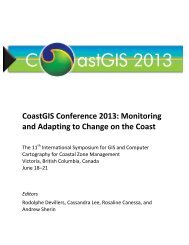in Context the SCotian Shelf - COINAtlantic
in Context the SCotian Shelf - COINAtlantic
in Context the SCotian Shelf - COINAtlantic
You also want an ePaper? Increase the reach of your titles
YUMPU automatically turns print PDFs into web optimized ePapers that Google loves.
whales, <strong>the</strong> sperm whale and <strong>the</strong> Nor<strong>the</strong>rn bottlenose<br />
whale, was carried out for <strong>the</strong> Scotian <strong>Shelf</strong> <strong>in</strong><br />
light of ongo<strong>in</strong>g petroleum exploration activities <strong>in</strong> <strong>the</strong><br />
area (LGL Llimited and Malme 2000).<br />
4.5 Pollution<br />
Shipp<strong>in</strong>g, petroleum exploration and development,<br />
disposal at sea (e.g., of dredg<strong>in</strong>g material) and fish<strong>in</strong>g<br />
activities all discharge wastes <strong>in</strong>to <strong>the</strong> mar<strong>in</strong>e<br />
environment. However, <strong>the</strong> largest source of mar<strong>in</strong>e<br />
pollution comes from land-based activities, <strong>in</strong>clud<strong>in</strong>g<br />
agricultural runoff, w<strong>in</strong>d-blown debris, <strong>in</strong>dustrial<br />
activity, and municipal waste-water (Environment<br />
Canada 2004). Stewart and White (2001) provide<br />
a general overview of contam<strong>in</strong>ants on <strong>the</strong> Scotian<br />
<strong>Shelf</strong>. Some mar<strong>in</strong>e sources of pollution on <strong>the</strong><br />
Scotian <strong>Shelf</strong> are briefly described here.<br />
The offshore oil and gas <strong>in</strong>dustry discharges treated<br />
water <strong>in</strong>to <strong>the</strong> mar<strong>in</strong>e environment. Oil and<br />
gas operators are expected to meet guidel<strong>in</strong>es<br />
published by <strong>the</strong> CNSOPB (CNSOPB/C-NLOPB<br />
2010). Discharges from <strong>the</strong> shipp<strong>in</strong>g <strong>in</strong>dustry<br />
are regulated; however, <strong>the</strong>re are <strong>in</strong>cidental and<br />
accidental releases of fuel, chemicals, ship debris<br />
and cargoes (Stewart and White 2001) as well as<br />
occasional major events, such as <strong>the</strong> s<strong>in</strong>k<strong>in</strong>g of<br />
<strong>the</strong> oil tanker, Arrow, <strong>in</strong> Chedabucto Bay <strong>in</strong> 1970<br />
(Environment Canada 2010). The major sources<br />
of pollution from <strong>the</strong> fish<strong>in</strong>g <strong>in</strong>dustry are lost or<br />
abandoned fish<strong>in</strong>g gear and garbage. Two studies<br />
carried out <strong>in</strong> <strong>the</strong> 1990s found that fish<strong>in</strong>g<br />
was <strong>the</strong> most important source of mar<strong>in</strong>e litter <strong>in</strong><br />
offshore areas of <strong>the</strong> Scotian <strong>Shelf</strong> (Lucas 1992;<br />
Dufault and Whitehead 1994). S<strong>in</strong>ce <strong>the</strong>n, fishermen’s<br />
organizations have been active <strong>in</strong> develop<strong>in</strong>g<br />
programs to encourage fishermen to br<strong>in</strong>g<br />
garbage back to shore. The federal government<br />
has also developed awareness brochures and<br />
o<strong>the</strong>r awareness tools (DFO 2007b).<br />
4.6 Cumulative Effects<br />
A cumulative effect may be def<strong>in</strong>ed as “a change<br />
to <strong>the</strong> environment caused by an action <strong>in</strong><br />
comb<strong>in</strong>ation with o<strong>the</strong>r past, present and future<br />
human actions” (Hegmann et al. 1999). Cumulative<br />
effects are important when <strong>the</strong> effects of an<br />
ocean use are persistent over time (i.e., difficult<br />
to reverse), such as pollution with heavy metals<br />
and some pesticides or large-scale destruction of<br />
habitat, or when activities are <strong>in</strong> close proximity <strong>in</strong><br />
time and space. When environmental effects of<br />
activities are considered separately, <strong>the</strong>y may all<br />
be below <strong>the</strong> threshold levels that cause impacts.<br />
Some effects, although thought to be transitory<br />
or of m<strong>in</strong>or importance on <strong>the</strong> scale of a s<strong>in</strong>gle<br />
source (e.g., a vessel discharge, an otter trawler,<br />
an oil well, or a seismic survey) may prove to be<br />
of more serious concern when comb<strong>in</strong>ed. Cumulative<br />
effects need to be addressed at vary<strong>in</strong>g<br />
scales, from local/site-specific to broader regional<br />
ecosystems.<br />
4.7 Multiple Use<br />
Some portions of <strong>the</strong> Scotian <strong>Shelf</strong> experience<br />
relatively high or <strong>in</strong>tensive levels of use, such<br />
as heavily fished areas, hydrocarbon production<br />
areas, and high vessel traffic areas. Parts of <strong>the</strong><br />
outer shelf and shelf break, for example, has been<br />
subject to an <strong>in</strong>creas<strong>in</strong>g <strong>in</strong>tensity of multiple use,<br />
<strong>in</strong>clud<strong>in</strong>g oil and gas development and a variety of<br />
fisheries. O<strong>the</strong>r areas rema<strong>in</strong> little to moderately<br />
used. Current and anticipated expansion, however,<br />
of exist<strong>in</strong>g uses (e.g., deep water fisheries) coupled<br />
with <strong>the</strong> potential for new ocean uses, such<br />
as offshore m<strong>in</strong>erals development or w<strong>in</strong>d power<br />
generation, underscores <strong>the</strong> grow<strong>in</strong>g requirement<br />
for effective multiple use management practices.<br />
http://co<strong>in</strong>atlantic.ca/<strong>in</strong>dex.php/state-of-<strong>the</strong>-scotian-shelf<br />
53













